
Gulls, or colloquially seagulls, are seabirds of the family Laridae in the suborder Lari. They are most closely related to the terns and skimmers and only distantly related to auks, and even more distantly to waders. Until the 21st century, most gulls were placed in the genus Larus, but that arrangement is now considered polyphyletic, leading to the resurrection of several genera. An older name for gulls is mews, which is cognate with German Möwe, Danish måge, Swedish mås, Dutch meeuw, Norwegian måke/måse and French mouette, and can still be found in certain regional dialects.

Laridae is a family of seabirds in the order Charadriiformes that includes the gulls, terns, noddies, skimmers, and kittiwakes. It includes around 100 species arranged into 22 genera. They are an adaptable group of mostly aerial birds found worldwide.

Larus is a large genus of gulls with worldwide distribution.

The common gull or sea mew is a medium-sized gull that breeds in the Palearctic. The closely related short-billed gull is sometimes included in this species, which may be known collectively as "mew gull". Many common gulls migrate further south in winter. There are differing accounts as to how the species acquired its vernacular name.
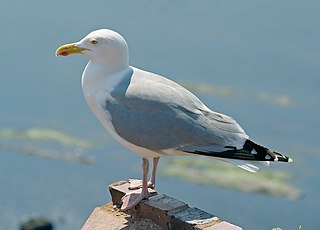
The European herring gull is a large gull, up to 66 cm (26 in) long. Common in coastal regions of Western Europe, it was historically more abundant. It breeds across Northern Europe, Western Europe, Central Europe, Eastern Europe, Scandinavia, and the Baltic states. Some European herring gulls, especially those resident in colder areas, migrate further south in winter, but many are permanent residents, such as in Ireland, Britain, Iceland, or on the North Sea shores. They have a varied diet, including fish, crustaceans, as well as some plants, and are also scavengers, consuming carrion and food left by or stolen from humans.

The great black-backed gull is the largest member of the gull family. Described by the Cornell Lab of Ornithology as "the king of the Atlantic waterfront", it is a very aggressive hunter, pirate, and scavenger. It breeds on the European and North American coasts and islands of the North Atlantic and is fairly sedentary, though some move farther south or inland to large lakes or reservoirs. The adult great black-backed gull has a white head, neck and underparts, dark grey wings and back, pink legs and yellow bill.

The lesser black-backed gull is a large gull that breeds on the Atlantic coasts of Europe. It is migratory, wintering from the British Isles south to West Africa. It has increased dramatically in North America, most common along the east coast. Formerly just a winter visitor, many birds are now spotted year-round. Some winters they occur in large numbers. Even on the west coast, this species has become an annual winter visitor in California with birds reported around most of the state each winter. They've even been seen in numbers at the Salton Sea. There is now serious concern about declines in many parts of the species range. The species is now on the RSPB Amber List because the UK is home to 40 per cent of the European population and more than half of these are found at fewer than ten sites.

The glaucous gull is a large gull, the second-largest gull in the world. The genus name is from Latin larus, which appears to have referred to a gull or other large seabird. The specific name hyperboreus is Latin for "northern" from the Ancient Greek Huperboreoi people from the far north "Glaucous" is from Latin glaucus and denotes the grey colour of the gull. An older English name for this species is burgomaster.

The Iceland gull is a medium-sized gull that breeds in the Arctic regions of Canada and Greenland, but not in Iceland, where it is only seen during winter. The genus name is from Latin larus, which appears to have referred to a gull or other large seabird. The specific name glaucoides denotes its resemblance to Larus glaucus, a synonym of Larus hyperboreus, the glaucous gull; -oides is Ancient Greek and means "resembling".
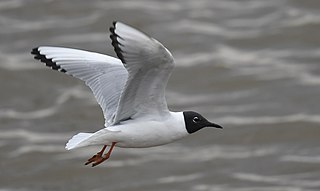
Bonaparte's gull is a member of the gull family Laridae found mainly in northern North America. At 28 to 38 cm in length, it is one of the smallest species of gull. Its plumage is mainly white with grey upperparts. During breeding season, Bonaparte's gull gains a slaty-black hood. The sexes are similar in appearance.

The yellow-legged gull is a large gull found in Europe, the Middle East and North Africa, which has only recently achieved wide recognition as a distinct species. It was formerly treated as a subspecies of either the Caspian gull L. cachinnans, or more broadly as a subspecies of the herring gull L. argentatus. The genus name is from Latin Larus which appears to have referred to a gull or other large seabird, and the species name honours the German zoologist Karl Michahelles.

The Caspian gull is a large gull and a member of the herring and lesser black-backed gull complex. The scientific name is from Latin. Larus appears to have referred to a gull or other large seabird, and cachinnans means 'laughing', from cachinnare 'to laugh'.

Sabine's gull also known as the fork-tailed gull or xeme, is a small gull. It is the only species placed in the genus Xema. It breeds in colonies on coasts and tundra, laying two or three spotted olive-brown eggs in a ground nest lined with grass. Sabine's gull is pelagic outside the breeding season. It takes a wide variety of mainly animal food, and will eat any suitable small prey.
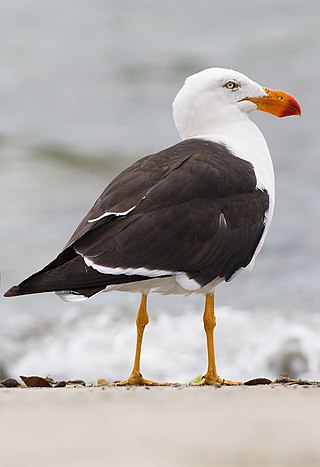
The Pacific gull is a very large gull, native to the coasts of Australia. It is moderately common between Carnarvon in the west, and Sydney in the east, although it has become scarce in some parts of the south-east, as a result of competition from the kelp gull, which has "self-introduced" since the 1940s.
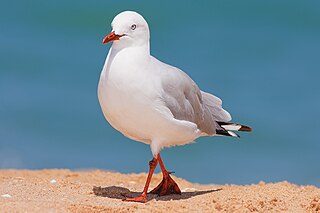
The silver gull is the most common gull of Australia. It has been found throughout the continent, but particularly at or near coastal areas. It is smaller than the Pacific gull, which also lives in Australia.

The California gull is a medium-sized gull, smaller on average than the herring gull, but larger on average than the ring-billed gull. It lives not just in California, but up and down the entire Western coast of North America, and has breeding ground inland. The yellow bill has a black ring.

The yellow-footed gull is a large gull, closely related to the western gull and thought to be a subspecies until the 1960s. It is endemic to the Gulf of California.
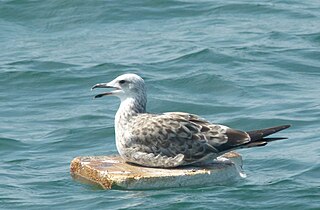
Heuglin's gull or the Siberian gull, is a seabird in the genus Larus.

Kumlien's gull is a subspecies of the Iceland gull. It is a large gull which breeds in the Arctic regions of Canada. It is migratory, wintering from Labrador south to New England and west across the Great Lakes. The subspecies is named after the naturalist Ludwig Kumlien. It is a regular vagrant in small numbers to Britain and Ireland.

The American herring gull or Smithsonian gull is a large gull that breeds in North America, where it is treated by the American Ornithological Society as a subspecies of herring gull.



















